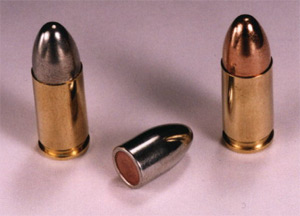
9×19 mm Parabellum
I realized that after going through my inventory of firearms, that I owned one Springfield Armory pistol in 9mm; the XDs® 4.0. The .45ACP cartridge has been my mainstay EDC cartridge for more years than I care to count. However, on occasion I do shoot and carry the 9mm. While I don’t have, to be honest, the confidence in the 9mm cartridge as I do the .45 ACP, I am willing to compromise as long as I have enough 9mm cartridges packed in a 9mm handgun to make me feel comfortable.
At some time in the past, and after viewing an autopsy of a person shot twenty-seven times (before his body finally gave out due to blood loss) with 9mm projectiles fired from two LEO service pistols, I can tell you that my confidence in the 9mm cartridge was not high. A high level of PCP in the person acted as a barrier for the brain to recognize that the projectiles’ entering into the body was taking a predicted toll on the body’s ability to remain functional. I decided that I should stick with my duty pistol at the time, the Sig Sauer P220 that carried a nice 8 + 1 capacity, having more confidence in the .45 ACP is a much better cartridge with which to do business.
Regardless of this, I have to say that I do like the 9mm cartridge; it is pleasant to shoot out of most every firearm chambered for it, it is a proven war-time cartridge and is the NATO standard cartridge, a lot of 9mm ammunition can be carried versus the .45 ACP cartridge, and a lot of LE agencies adopted the cartridge for duty us. However, after the 1986 FBI Miami shootout, the 9mm cartridge was destined to be replaced as a duty round. After a series of evaluations, the .40S&W cartridge (sometimes referred to as the 10mm Short) was selected as the ‘go-to’ cartridge for the FBI, and many LE agencies followed suit. That didn’t mean that the 9mm cartridge was going by the wayside, and hasn’t lost a following. The future of the .40 S&W; however, may be questionable but that remains to be seen.
There are three common bullet weights for the 9mm; 115-grain, 124-grain (the 9mm was built around this round), and the 147-grain. The mainstay has been the 124-grain version. Since the early days, and for some reason, the 147-grain version was not pushed very hard. This version was slower than the other weights and it seemed that speed and not weight was the driving force for the 147-grain not being deemed an acceptable cartridge for duty or personal defense use.
That was then and this is now. Improvements in all 9mm ammunition have pushed the 9mm cartridge back into the spotlight as a preferred defensive cartridge by many. The .40 S&W was (is) a trade-off cartridge. Something was needed other than the full-blown 10mm cartridge and a debate much like the .38 special vs. .357 magnum started. The .40 S&W is as under-powered 10mm cartridge, but it was bigger, heavier and faster than the 9mm cartridge, it was also smaller, faster and lighter than.45 ACP cartridges, and a lot of them could still be carried. The .40 S&W cartridge operates at a much higher pressure than both the 9mm and .45 ACP cartridges. Thus, a lot of folks decided that if recent advances in cartridge design for the 9mm could almost equal the .40 S&W, there was little reason to change calibers. I, for one, am one of those people. I have an investment in 9mm and I could not justify moving into the .40 caliber arena, but I do enjoy firing the .40 caliber cartridge at times because I can, although doing so involves a range rental pistol.

Springfield Armory XDm 9mm 4.5.
Now that I’ve digressed enough, let’s get going on the Springfield Armory XDm® 9mm 4.5. I had taken two different 9mm cartridges to the range for experimentation purposes; Speer 124-grain GDHP and Hornady Custom 9mm Luger 147-grain XTP. With me, I had the Ruger SR1911 in 9mm and wanted to do the comparison of the two cartridge types with that pistol. However, I was also interested in a pistol that could carry more 9mm cartridges than I could with the SR1911 (8+1 with a standard magazine). Throughout the week, I had been pursuing information regarding different high capacity 9mm pistols. Why would I do that? After all, I just posted an article regarding the CZ75B that is an excellent example of a high-capacity 9mm pistol. I agree that it is a fine example. But, here is the funny part; I care about the pistol. I really don’t want it subjected to daily wear and tear. I don’t want its finish affected by sliding in and out of a holster. I don’t want it to have any nicks or scratches. I want to baby the pistol. I needed a pistol that I don’t want to baby; a pistol that is a tool, a companion more than an honored quest and with reasonable care could be relied upon at any time. This drove me into a search for a more ‘utility’ type of tool. A comparison of a lot of ‘utility’ tools took place.
I was able to shoot a Springfield Armory XDm® 9mm 4.5 at the range. I had shot the Glock G17, the M&P, a Ruger SR9, and an FN on previous occasions along with some others. The Springfield Armory 9mm 4.5 stood out for me. I could shoot it as well as my 1911. In fact, it was the only pistol that I could shoot as well as my 1911 in 9mm, although it is wider, longer, and has less weight than the 1911 in the same caliber. Plus, the Springfield Armory XDm® 9mm 4.5 can carry 19+1 rounds of 9mm ammunition (two 19-round magazines comes with the pistol for those of us that live in “free” states).
The 4.5 Barrel and Slide:
The Springfield Armory XDm® 9mm 4.5 would be considered a ‘service’ pistol, which means that concealing it is a bit of a challenge. Even the Springfield Armory XDm® 9mm 3.8 carries 19+1 cartridges, with the difference being barrel length. The sub-compact version comes with 13-round capabilities and with the 3.8 barrel.
Of course, it is not the barrel that is hard to conceal, it is the butt of the pistol. However, the width of the frame at the grip is really not that much wider than the 1911 and is the same length, and with a proper holster and wearing appropriate clothing, I felt that I could accommodate concealing the Springfield Armory quite well.
The sight radius is longer than the Glock G17 and also the 1911. I could actually view the sights on the Springfield Armory XDm® 9mm 4.5 better than quite a few other pistols. The beveled slide, although the same width (if not more) than that found on the Glock G17, gave the impression that the slide is thinner than it actually is. The 3-dot sight setup works for me in this instance. I have read; however, that the white inset does not fare well with cleaning solutions. With that in mind, a drop of fluorescent red on the front sight and use a dot of clear on all the dots should be satisfactory. I have no inclination to switch to night sights. With that said, the front sight on the example shown at Springfield Armory’s web site is a fiber-optic version on an all-black Melonite pistol – and this is the version that I have. Of course, there are the proponents and opponents of fiber-optic sights. I have never had an issue with fiber-optic front sights and if the pistol that I am shooting has them it’s as fine as when it does not.
The slide height has been a source of commenting for others. Most say that they think the slide is too high – as compared to a Glock pistol, for example. Therein lays the problem. While the Springfield Armory XD/XDm pistols may be compared to a Glock pistol, the fact remains that the Springfield Armory XD/XDm pistols stand alone in their own right and I feel that they should be weighed using their own merits or demerits. But, it is only normal to compare something against a ‘standard’ and Glock pistols have become the de facto standard for polymer-framed pistols. Personally, I have no issue with the height of the slide; it looks fine, works fine, and does what it’s supposed to do.
The slide is easily removed from the frame. After ensuring that the pistol is unloaded and safe, retract the slide and lock it into place with the Slide Lock Lever. Rotate the Disassembly Lever to the ‘Up’ position. While holding the slide and frame, push the Slide Stop Lever down to release the slide. Slowly remove the slide from the pistol. There is no holding the slide in place by hand while fumbling with a slide release mechanism or having to pull the trigger before removing the slide.
To install the slide assembly, simply slide the slide assembly into place, lock it place with the Slide Stop Lever, move the Disassembly Lever to the horizontal position, and push the Slide Stop Lever down while holding the frame and slide firmly. Then, slowly lower the slide into battery.
The one thing about the Springfield Armory XDm® 9mm 4.5 that surprised me was the lack of a captive recoil spring. The full-length guide rod is steel and the recoil spring is tightly fitted to the guide rod. The guide rod base fits into a ‘guide rod well’ that is part of the barrel.
The texturing of the slide serves up plenty of surface for retracting the slide – front and rear. Although the ‘range’ version of the Springfield Armory XDm® 9mm 4.5 that I shot earlier is a ‘two-tone’ version, I prefer the all black Melonite version for CC. At the time of this writing, the all black Melonite version is all that is available for this pistol.
The Frame:
I find the external controls (Disassembly Lever, Slide Stop Lever, and Magazine Release Buttons) on the Springfield Armory XDm® 9mm 4.5 to be more than adequate. Some might say that they are too big, but they work for me. With the pistol in my hand, I can reach the Slide Stop Lever and Magazine Release Button just fine. The Magazine Release Button is ambidextrous, which is a nice feature when operating the pistol left handed. When new and just out of the box, the Magazine Release Button was hard to press and was very gritty in feel. A drop of Ballistol on each button shaft cured that issue. With a fully-loaded magazine (19 rounds) inserted into the pistol, releasing the magazine is not going to happen; there is just too much pressure exerted on the release mechanism for it to work as it should. At eighteen rounds; however, the magazine released just fine.
The most controversial feature of the Springfield Armory XD® and XDm® pistols has been the grip safety. Frankly, I have no issue with it after using one on my 1911 pistols for so long. This feature was one of the reasons for my choosing the Springfield Armory XDm® 9mm 4.5 over some of the others tested. The pistol will not fire unless the trigger and grip safety are pressed properly. The hardest transition for me is not having a thumb safety, but I transition easily from one pistol to the next. Coupled with the trigger safety, there is an added degree of safety that is not present on some polymer pistols, especially when holstering the pistol. Of course, keeping my finger off the trigger is a key factor. Note that the grip safety does not need to be pressed to retract the slide. Again, the grip safety might turn someone off from purchasing the pistol, but it is not a deal breaker for me; it is just another factor in the manual of arms for the pistol.
Out of many 9mm polymer pistols held, I find the grip of the Springfield Armory XDm® 9mm 4.5 the best of them all. The angle of the grip agrees with my hand. The texturing of the grip is not abusive to my hand or as slippery as I find the grip on some other polymer pistols. I have ‘Word Smith’ hands, which means that I feel every nook and cranny of the texturing and the grip on this pistol feels just fine in my hand.
The ‘medium’ back-strap (The back-strap that came mounted on the pistol) seems to work well for me. The Springfield Armory XDm 9mm 4.5 comes with three back straps to accommodate different hand sizes.
Although wider, the grip length is no longer than that of my 9mm 1911 and, somehow, nineteen rounds of 9mm ammunition can be held inside the magazine (and, yes 19 rounds will fit in the magazine with the help of an UpLula loading tool). I feel more comfortable knowing that fact. As I mentioned previously, the grip angle is also similar that that found on my 1911-based pistol. Aside from the width of the grip, this might be the reason why the grip feels comfortable in my hand.
I am not a fan of rails, but the Springfield Armory XDm® 9mm 4.5 comes with one and I’ll learn to live with it. Besides, there are inserts available that can ‘smooth’ out the rail area if I feel the need to do so.
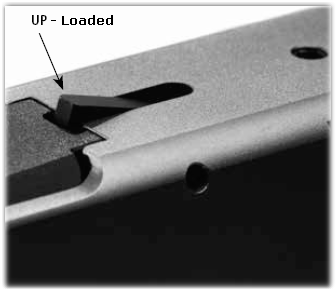
Chamber Loaded Indicator.

‘Cocked” Indicator
The Springfield Armory XDm® 9mm 4.5 also is equipped with a chamber-loaded indicator; a little pop-up device that tells you that a round is chambered (well, duh!) and a ‘cocked’ indicator, which is a small pin that protrudes from the rear of the slide when the pistol is cocked. Put the two together and you have a ‘stocked-and-cocked’ pistol.
The internals of the Springfield Armory XDm® 9mm 4.5 are robust. There is plenty of STEEL rail for which the slide can, well, slide.
While I like the aesthetics of the pistol for the most part, this pistol is intended for use as a ‘utility’ tool, which means that although it look pleasing and well-balanced, it is meant to be carried daily and shot often. And, this brings us up to the important part – how it shoots.
Range Time:
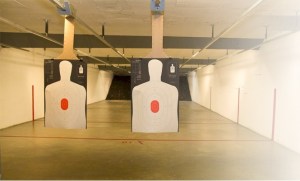 As I mentioned earlier, I was testing 124-grain and 147-grain ammunition. Given that the test unit was a range rental and had who knows how many projectiles shot through it, there were absolutely no malfunctions and I expected nothing less with the newly-acquired pistol. That can also be said about any new XD series pistol that I have purchased new. These pistols are simply ready to rock from jump. If anything needs to be broken in, it is the operator handling them.
As I mentioned earlier, I was testing 124-grain and 147-grain ammunition. Given that the test unit was a range rental and had who knows how many projectiles shot through it, there were absolutely no malfunctions and I expected nothing less with the newly-acquired pistol. That can also be said about any new XD series pistol that I have purchased new. These pistols are simply ready to rock from jump. If anything needs to be broken in, it is the operator handling them.
With the newly-acquired Springfield Armory XDm® 9mm 4.5, both 124-grain and 147-grain bullets provided a hair over 1” group at 21-feet while firing off-hand. I could not tell any difference between the two groups of impacts at that distance. Felt recoil and muzzle jump is very low with, in my opinion, the 147-grain cartridge being more of a push than a sharp impulse as with the 124-grain cartridge. While I am on the mention of low, the Springfield Armory XDm® 9mm 4.5 shot slightly low at 21-feet. How low? Essentially, this example was a ‘place the barrel over what you want to hit’ type of pistol, which is what I like. The sight height comes into play at this distance. Combat work at this distance simply means that you point the pistol and the pistol will do the rest. I have full confidence in the Springfield Armory XDm® 9mm 4.5. At this point, let me mention the trigger.
Of all the 9mm polymer pistols that I have fired, I like the trigger of the Ruger SR series (SR9, SR40, and SR45) pistols the best. The Springfield Armory trigger comes in second and Glock coming in third. But, that’s just me and you and I may not agree – and that’s just fine. There is some take-up in the trigger and it is soft. The trigger breaks clean at a point well to the rear of travel and measures (new) 7 pounds and 4 ounces average with the best trigger pull weight of 6 pounds 3 ounces being recorded. Some over-travel is exhibited. The trigger seems heavy if you are using the pad of the trigger finger to actuate it. I tend to shoot with my trigger finger at the first joint with my 1911-based pistols and, to me; the Springfield Armory trigger favors my style of trigger pull and does not feel heavy at all. In fact, it feels good for me. Trigger reset is also long, but I can shoot the pistol without having to take my finger off of the trigger until I desire to do so. At approximately .21 inches of rearward travel, the pistol is cocked. For defensive purposes, and for me, the trigger is fine as is. For non-defensive uses, I would have the trigger worked on by a competent and qualified gunsmith. With this said, Springfield Armory claims (in the User Manual) that the trigger is a ‘target trigger’ that, to me, is a false statement; there is nothing ‘target’ about the trigger, and ‘utilitarian’ would be a better description.
While 21-feet (7 yards) is a nice distance for function testing and ‘combat’ work, seeing what the pistol is capable of at distance further than 21 feet is, I feel, a better test. The target was moved to 15 yards and then to 25 yards. I will say that I would have qualified with the pistol for LEO work, but I still need a lot of trigger time with the Springfield Armory XDm® 9mm 4.5 before I can consider myself truly proficient at varying distances. The pistol is quite capable of producing excellent accuracy, more so than this shooter.
There were absolutely no issues with the pistol. I have come to expect “ready to go out of the box” performance in regard to Springfield Armory products, and that expectation has not been curtailed in the least.
Carrying Concealed:
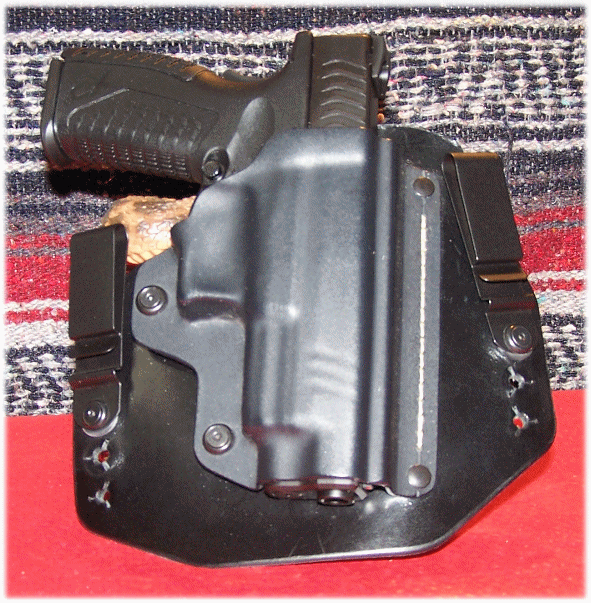
XDm 9mm 4.5 in Black Arch Holster Adjusted to my Preferences for IWB Carry.
Holsters for the pistol are available wide and far. Since I had a previously-purchased Black Arch ACE-1 GEN2 holster (no longer produced) for the XDm® 4.5 in .45 ACP, I saw no need for another holster to add to the drawer. The 9mm version of the XDm® 4.5 fits just as well as the .45 ACP version of the pistol. As my usual, a large portion of the sweat guard was removed to accommodate a clear path to the butt of the pistol. In the case of the Springfield Armory XDm® 9mm 4.5, I found that raising the two adjustment screws up one hole on the holster yielded the near-proper depth of the holster for my style of carry. I have a long reach and prefer my IWB holster as low as possible within the trousers. As now adjusted, the rear of the slide rests just under the rib cage. The Springfield Armory XDm® 9mm 4.5 is a ‘service-sized’ pistol. Like its brethren in .40 and .45 calibers, it is a lot of pistol to conceal. While the Springfield Armory XDm® 9mm 4.5 does not have the weight of an all-steel 1911 in the same caliber, the bulk of the XDm® 9mm pistol lets you know that you are carrying a substantial pistol.
Since I always wear an undergarment, I was not concerned about the butt of the pistol rubbing against bare skin. The holster that I have would also be suitable for the compact and sub-compact versions of the pistol, if I desired to invest in one for summer carry.
But, Weight! There’s More:
The weight of the Springfield Armory XDm® 9mm 4.5 is 29 ounces empty. Add nineteen rounds of 124-grain Speer Gold Dot 9mm ammunition @ 0.450 ounce/cartridge and you have a gross weight of about 37 ounces riding on the hip. For comparison sake, the Glock G17 (17-round) weighs a mere 32.2 ounces fully loaded with two less rounds than the XDm® 9. Just to place things into contrast, an all-steel Government Model 1911 carrying 9 rounds of the same ammunition would weigh in at around 44.8 ounces. The Ruger Lightweight Commander in 9mm weighs about the same as the Glock G17, but the Ruger 6722 holds only nine rounds of ammunition. Again, I hate to compare the Springfield Armory XDm® 9mm 4.5 to any other firearm, and many would consider the Springfield Armory XDm® 9mm 4.5 on the heavy side, but that ‘heavy side’ certainty makes the pistol more pleasant to shoot than a lighter pistol in the same caliber.
When empty, the Springfield Armory XDm® 9mm 4.5 feels ‘barrel heavy.’ But, we don’t carry empty pistols do we? Add nineteen + one rounds of ammunition and the weight shifts to the handle, but the pistol feels better balanced. At about fifteen rounds, the pistol feels near perfectly balanced to me.
The Wrap-Up:
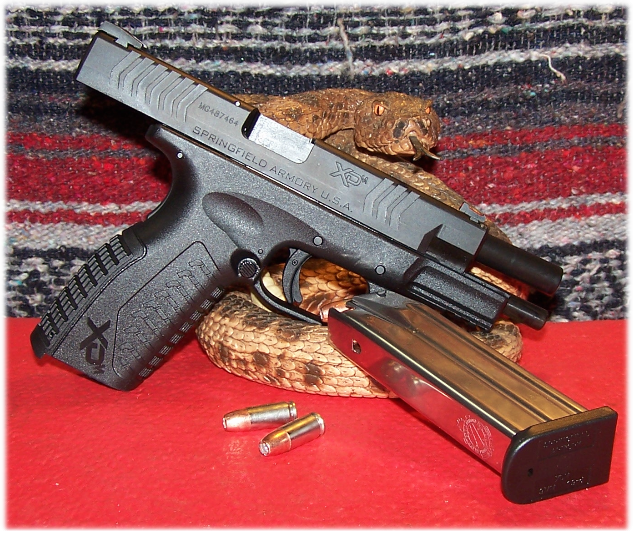
Springfield Armory XDm® 9mm 4.5 and 19+1 Rounds of 9mm Ammunition.
The current MSRP for the Springfield Armory XDm® 9mm 4.5 is $624. However, it can be found for quite a bit less if you do your shopping. For the money, you get a pistol that is well worth the cost, and that can’t be said about a lot of firearms. But, you are free to spend your money whenever, wherever, however, and on whatever you want.
If the 4.5 version doesn’t tickle your fancy, there is the 3.8 Compact with a 19 round capacity and a 3.8 Sub-Compact (13-round) that also comes with a 19-round magazine and adapter sleeve that you can use as a primary or spare magazine. But Wait, there’s more! The Springfield Armory XDm 9mm also comes in the 5.25 version. I have the 5.25 in .45 ACP and it is an excellent shooter, but not one that I would carry as an EDC.
The testing of the range rental Springfield Armory XDm® 9mm 4.5 was very favorable. The test shoot, coupled with some research, convinced me that one of these should be part of the family. With that, I will leave you with a question. There are double-stack 1911 pistols in .45 ACP. There is also one (as far as I know of) double-barreled 1911 in .45 ACP. Why has no one come up with a double-stack 1911 in 9mm? (Author’s Note: I have since learned that a double-stack 9mm 1911 does exist; The Double-Stack Nighthawk Dominator, a Premium 9mm 1911.)
Is the Springfield Armory XDm® 9mm 4.5 the pistol for you? I can’t answer that. But, I can say that the pistol would be an excellent tool for HD or SD. The ergonomics of the pistol works well in my hand, I shoot it well, it functions well, holds a whole bunch of cartridges, and I cannot ask for more than that out of a HD or SD tool. I can; however, ask more out of an operator – like myself.
Don’ Jus’ Take My Word for It!
There are quite a few written articles regarding the Springfield Armory XDM 4.5 in 9mm. A sampling is listed below
- Springfield Armory XDM 4.5: http://www.guns.com/reviews/Springfield Armory-armory-xdm-4-5/
- Gun Review: Springfield Armory XD(m) 4.5: http://www.thetruthaboutguns.com/2015/05/tyler-kee/gun-review-Springfield Armory-armory-xdm-4-5/
- Pat Cascio’s Product Review: Springfield Armory XDm 9mm: https://survivalblog.com/pat-cascios-product-review-Springfield Armory-armory-xdm-9mm/
A few videos regarding the pistol:
- Springfield Armory XDM 9mm Review: Better Than Glock 17 / 19. One of the Best Full Size Pistols (XD, XD M): https://www.youtube.com/watch?v=T_ZFxSv5-lY
- Springfield Armory XDm 9mm 4.5″ Pros and Cons: https://www.youtube.com/watch?v=vwX1GdoxLZs
- Springfield Armory XD-M 9mm – Why You Should Own One: https://www.youtube.com/watch?v=Gun4413tg4I
- If you are interested in the Springfield Armory XDm 9mm in 3.8, Hickock45 can help you with that: https://www.youtube.com/watch?v=gomyryr5uno
![]()

